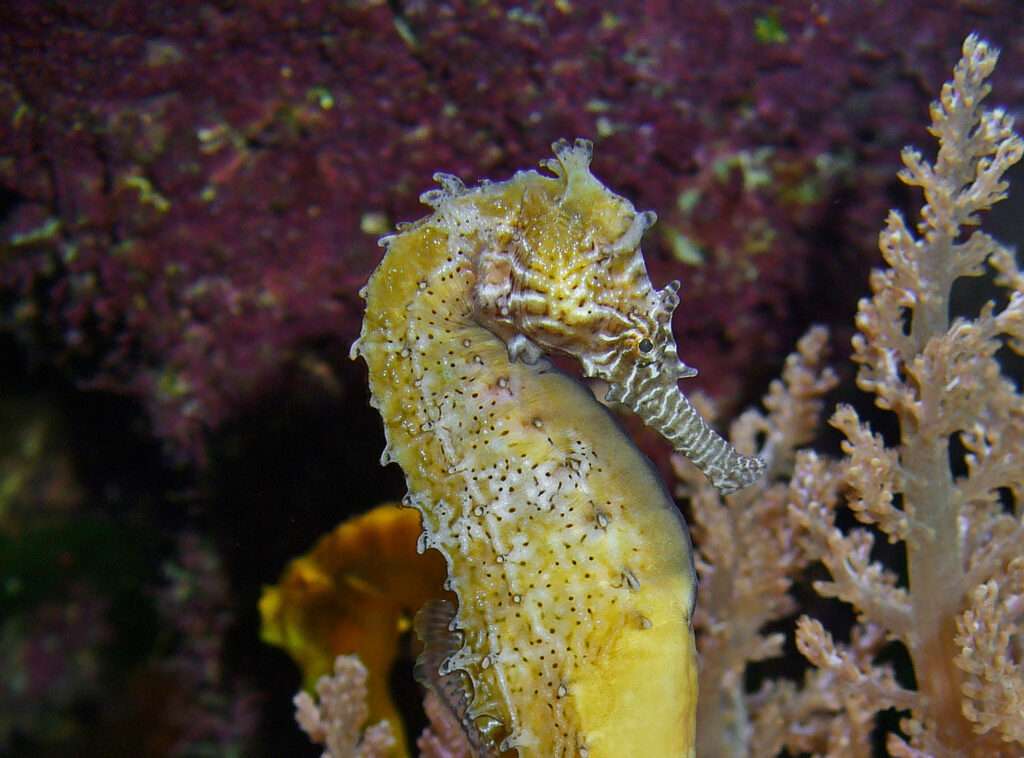
These fish can be housed at tropical temperatures, but they also do well at room temperature, which is between the upper 60s and low 70s. As long as it doesn’t change, they can handle a specific gravity of 1.019 to 1.025. An extremely resilient seahorse, however feeding them takes a lot of effort. As the fish do not actively hunt but instead wait for a prey item to drift by, this species requires a tiny aquarium to concentrate its food. The fish’s prehensile tail should have a lot of places to hold onto. A tiny predator that seldom ever consumes non-living things. Brine shrimp that have just hatched are sufficient for fry and adults, although a diversified diet of brine shrimp, small mysis, and “pods” like amphipods and copepods is preferable.
All seahorses have daddies who are pregnant most of the time. In captivity, this species reproduces easily. The males’ brood pouch is where the female lays her eggs, where the embryos develop before giving birth. Fry may be kept with the parents or separated and placed in a grow-out tank.
Habitat
Hippocampus zosterae, more often known as the dwarf seahorse, is found in coastal waters of the western Atlantic Ocean, including the Caribbean Sea, the Gulf of Mexico, and the continental shelf of the southeast United States. In shallow tropical seas with seagrass beds, Hippocampus zosterae typically inhabits regions with high concentrations of eelgrass (Zostera marina). Additionally, mangrove roots, coral, and floating plants all contain them.

Physical Appearance
Seahorses swim upright while being propelled by their dorsal fin, and have heads that are at a straight angle to their bodies. They use their pectoral fins, which are situated behind the head on both sides, to steer. Seahorses are unusual because of their prehensile tails, which can be utilized to secure the animal to coral, sea grass, or other suitable holdfasts. This tail lacks a caudal fin. The large number of bone plates that make up a seahorse’s absence of scales are evident as rings around the trunk and tail.
The amount of trunk rings a seahorse has and the coronet on top of its head, which is as distinctive as a person’s thumbprint, are two ways to identify them. The young differ from their parents in that they have more spines, higher coronets, and larger heads relative to their bodies. Seahorses have different sexes. While females have longer trunks, males have longer bodies and tails. Additionally, males have a brood pouch, whereas females do not.
One of the smaller species of seahorses, measuring between 2 and 2.5 cm, is the Hippocampus zosterae. A male with a maximum reported size of 5.0 cm. The presence of 10 to 13 dorsal and pectoral fin rays sets this species of seahorse apart from others found in the western Atlantic. A short snout that is one-third the length of the head, nine to ten trunk rings, a body covered in knob-like spines, and skin coated in microscopic warts are further characteristics of dwarf seahorses. Additionally, the dorsal fin of Hippocampus zosterae contains a submarginal band. In addition to being seen in beige, yellow, green, and black, dwarf seahorses can also have white speckles or dark patches.
Food Habits
Living prey, including small crustaceans like amphipods, tiny shrimp, various small invertebrates, and fish fry, make up the diet of Hippocampus zosterae. Because they blend in with their surroundings, seahorses are opportunistic hunters who wait while tethered by their tail for food to get close enough to consume without moving from the anchor. The seahorse reaches toward the prey once it is spotted and sucks it via the snout.
The small mouth cavity is widened by the hyoid bone retracting, which lowers the jaw and increases the concentration and siphon at the top of the gills’ outflow of water from the snout. Seahorses don’t have stomachs or teeth. Additionally, because food moves through the digestive system so quickly, many nutrients are not always absorbed. Because of this, seahorses both in the wild and in captivity need a lot of food to survive. Up to 3,000 brine shrimp can be eaten by seahorses every day.
Economic Importance for Humans
Chinese medicine practitioners think that these animals can treat asthma and impotence, decrease cholesterol, and stave off arteriosclerosis. Due to the magical myths associated with these unusual creatures as well as the fact that male seahorses lay eggs and give birth to their offspring, humans have long regarded seahorses as valued and powerful beings. In research and education, seahorses are crucial.
The unique way that seahorses reproduce and mate, with the father protecting the developing young in his brood pouch and giving them air and nourishment, offers humans an intriguing. This hypothesis is intriguing since it contrasts with the behavior of many mammalian species.
Table





